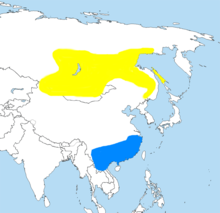Pallas's Wabler breeds in mountain forests from southern Siberia east to northern Mongolia and northeastern China. It is named for German zoologist Peter Simon Pallas, who first formally described it. It is strongly migratory, wintering mainly in southern China and adjacent areas of southeast Asia, although in recent decades increasing numbers have been found in Europe in autumn.
The record on 18 April this year was the first spring record for Bardsey and for Wales. So when another arrived here today, we began to wonder what was happening!




| Phylloscopus proregulus (Pallas, 1811) | |
 | |
Breeding summer visitor
Winter visitor |

Pallas's Warbler taken from SBO website - photo Dan Branch
A fantastic recovery, but the one question we all want to know is where it spent the intervening seven months! Presumably wintering somewhere in Southern Europe or North-west Africa. This is undoubtedly our most exciting bird of the year so far, and a great illustration of the fact most spring Sibes surely are returning North having successfully overwintered. Will Pallas's Warbler one day be nothing more than a scarce winter visitor and spring migrant through Europe, with a secondary migration route to its breeding grounds established? This recovery posed many, many more questions than it can possibly answer, but it will be fascinating to monitor the occurrences of this and other eastern rarities over the coming years.
It was a fine day to be out, even without a cracking rarity. A good scattering of migrants featured highlights of a Wood Warbler, two Pied Flycatchers, singles of Whinchat and Ring Ouzel and an excellent five Lesser Whitethroats. Also noted were 83 Willow Warblers, 36 Wheatears, 20 Whitethroats, 18 Lesser Redpolls, 14 Chiffchaffs, 11 Sedge Warblers, eight Spotted Flycatchers, seven Blackcaps, three Garden Warblers, three Redstarts, two Yellow Wagtails, two White Wagtails, two Rooks, two Collared Doves and singles of Siskin and Grasshopper Warbler.

Pied Flycatcher

Lesser Whitethroat
Out to sea, an early morning burst of 218 Guillemots were on the move in the first two hours of daylight. There were also 96 Kittiwakes, 56 Manx Shearwaters, 39 Gannets, two Puffins and singles of Black-headed Gull and Great Northern Diver.
No comments:
Post a Comment